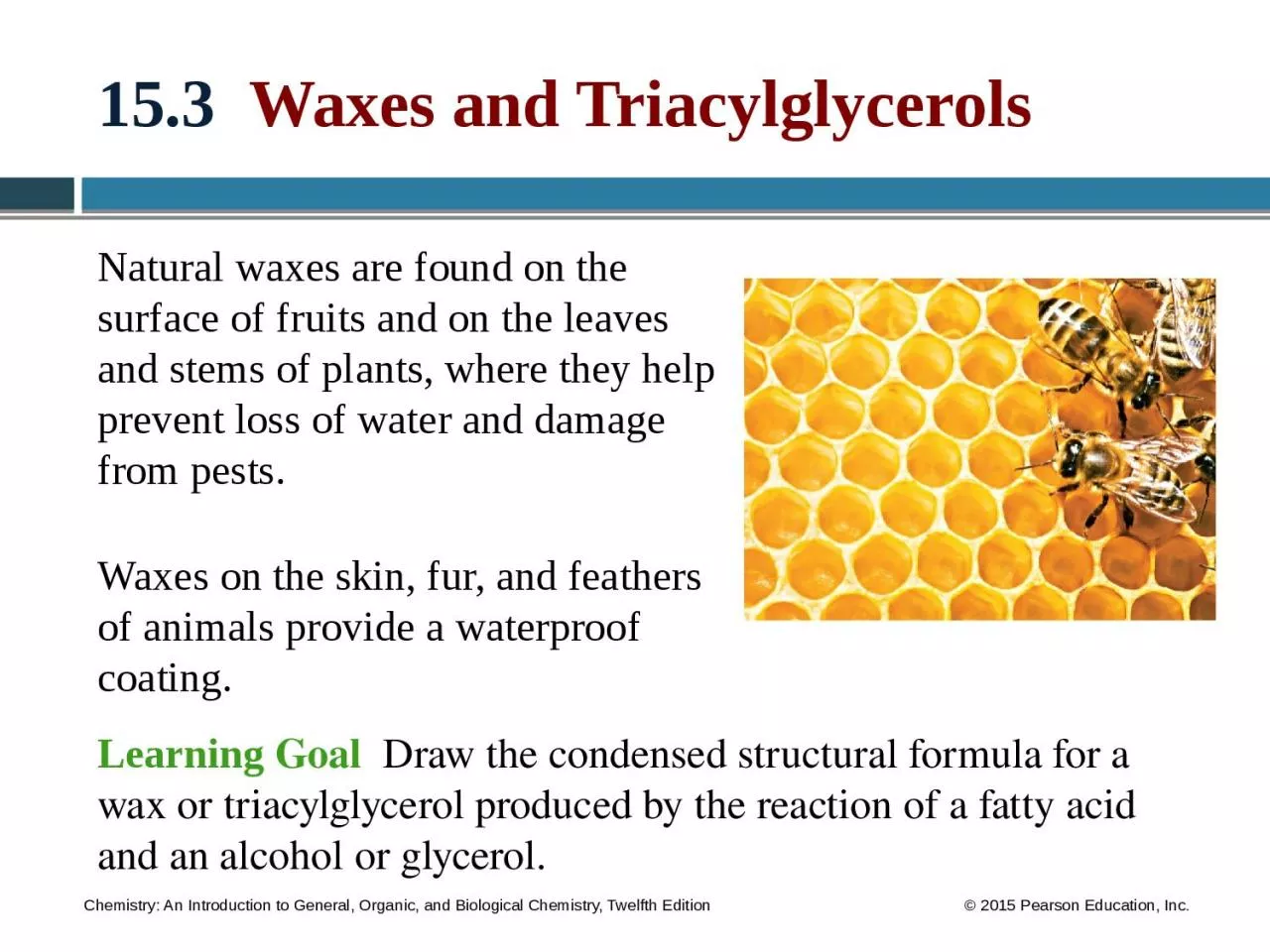

Natural waxes are found on the surface of fruits and on the leaves and stems of plants where they help prevent loss of water and damage from pests Waxes on the skin fur and feathers of animals provide a waterproof coating ID: 927592
Download Presentation The PPT/PDF document "15.3 Waxes and Triacylglycerols" is the property of its rightful owner. Permission is granted to download and print the materials on this web site for personal, non-commercial use only, and to display it on your personal computer provided you do not modify the materials and that you retain all copyright notices contained in the materials. By downloading content from our website, you accept the terms of this agreement.
Slide1
15.3 Waxes and Triacylglycerols
Natural waxes are found on the surface of fruits and on the leaves and stems of plants, where they help prevent loss of water and damage from pests.Waxes on the skin, fur, and feathers of animals provide a waterproof coating.
Learning Goal Draw the condensed structural formula for a wax or triacylglycerol produced by the reaction of a fatty acid and an alcohol or glycerol.
Slide2WaxesWaxes
areesters of saturated fatty acids and long-chain alcohols, each containing from 14 to 30 carbon atomscoatings that prevent loss of water by leaves of plants
Slide3Typical Waxes
Slide4Triacylglycerols
In the body, fatty acids are stored as triacylglycerols (triglycerides), which areesters of
glycerol (a trihydroxy alcohol) and fatty acidsformed when three hydroxyl groups of glycerol react with the carboxyl groups of three fatty acidsnamed by changing glycerol to glyceryl and naming the fatty acids as carboxylates
Core Chemistry Skill
Drawing Structures for Triacylglycerols
Slide5Triacylglycerol: Glyceryl Tristearate
The name of the fatty acid formed with three stearic acids becomes glyceryl tristearate.The common name of this compound is tristearin.
Slide6Mixed Triacylglycerols
Triacylglycerol may contain different fatty acids, such as the triacylglycerol made from stearic, oleic, and palmetic acids.
Slide7Triacylglycerols: Energy StorageTriacylglycerols are the major form of energy storage for animals.
Animals that hibernate eat large quantities of plants, seeds, and nuts that are high in calories. As the external temperature drops, the animal goes into hibernation and the body temperature drops to nearly freezing, reducing cellular activity, respiration, and heart rate.
Slide8Triacylglycerols: Energy StorageDuring hibernation, the animal
’s stored fat in the form of triacylglycerols is its only source of energy.
Prior to hibernation, a polar beareats food with a high caloric content.
Slide9Study CheckWhat are the fatty acids in the following triacylglycerol?
Slide10Solution
stearic acid
oleic acidmyristic acidWhat are the fatty acids in the following triacylglycerol?
Slide11Drawing the Structure of a TriacylglycerolDraw the condensed structural formula for glyceryl tripalmitoleate (tripalmitolein).
SOLUTION:Glyceryl tripalmitoleate (tripalmitolein) is the triacylglycerol that contains ester bonds between glycerol and three palmitoleic acids acid molecules.
Slide12Drawing the Structure of a TriacylglycerolDraw the condensed structural formula for glyceryl tripalmitoleate (tripalmitolein).
Slide13Study Check
Draw the condensed structural
formula for the triacylglycerol containing three molecules of myristic acid (14:0).
Slide14Solution
Draw the condensed structural
formula for the triacylglycerol containing three molecules of myristic acid (14:0).
Slide15Melting Points of Fats and OilsA
fat is usually solid at room temperatureusually comes from animal sources such as meat, whole milk, butter, and cheeseAn
oilis usually liquid at room temperatureis usually obtained from a plant source such as palm oil and coconut oil
Slide16Oils with Unsaturated Fatty AcidsOils
fromolive and peanut are monounsaturated; they contain large amounts of oleic acidcorn, cottonseed, safflower seed, and sunflower seed are polyunsaturated because they contain large amounts of fatty acids with two or more double bondspalm and coconut are solids at room temperature because they consist mostly of saturated fatty acids
Slide17Saturated and Unsaturated Melting Points
Saturated fatty acids have higher melting points than unsaturated fatty acids because they pack together more tightlyare usually found in animal fats and in coconut and palm oils
Slide18Percent Saturated and Unsaturated Fatty Acids in Fats and Oils
Vegetable oils have low melting points because they have a higher percentage of unsaturated fatty acids than do animal fats.